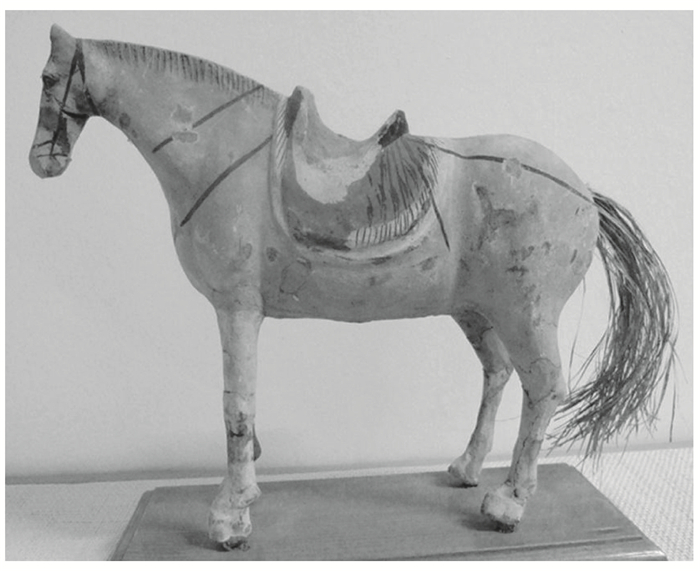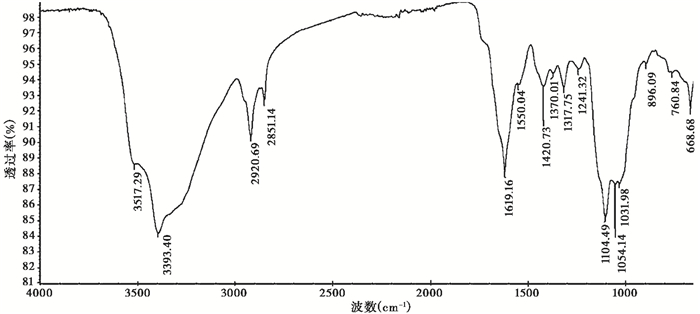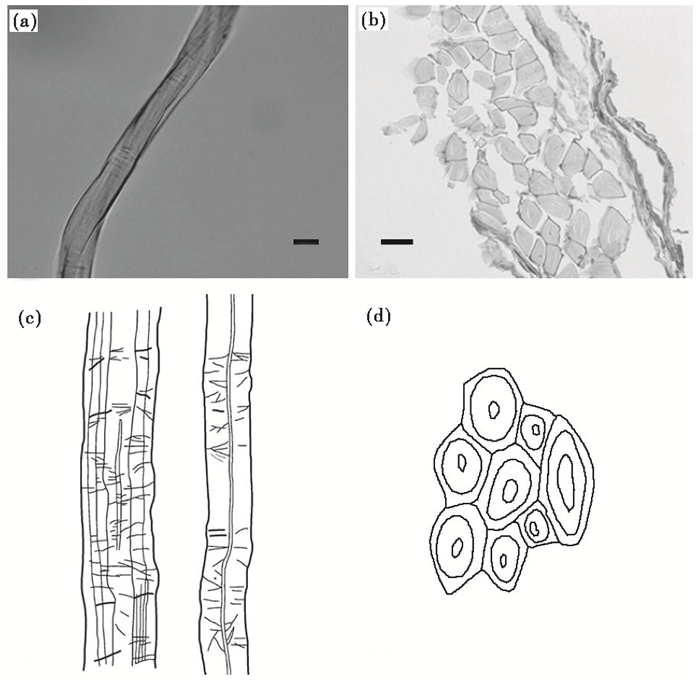2 新疆维吾尔自治区博物馆, 新疆 乌鲁木齐 830091;
3 中国国家博物馆, 北京 100006;
4 云南大学古生物研究重点实验室, 云南 昆明 650091;
5 中国科学院大学考古学与人类学系, 北京 100049)
吐鲁番盆地深居欧亚大陆腹地,日照丰富,降水稀少,素有中国“干极”之称。极端干旱的大陆性气候为古代遗存提供了一个良好的环境,保存下来数以万计的珍贵文物。阿斯塔那古墓群即是其中的典型代表,从西晋到唐代中叶一直被作为古代高昌地区城乡官民的公共墓地,使用时间长达数百年之久。自1959年以来,新疆文物考古研究所等单位对其进行了13次大规模的考古发掘,后来又作了数次零星的清理,累计共发掘了500多座墓葬。与同时期内地的墓葬相似,阿斯塔那古墓群的唐代墓葬中也出土了大量的马俑,造型优美,色彩亮丽[1]。最大的区别是前者以唐三彩等陶俑为主,而后者随葬的绝大多数为泥俑,这种现象在国内的考古发现中颇为少见。
已有的考古发现表明我国古代有机质材料常被用于装饰随葬俑,例如汉阳陵出土了大量断臂陶俑。发掘者根据残留的痕迹推测这些陶俑的手臂和衣服可能来源于植物材料,但囿于保存条件的限制,这些植物材料在埋藏过程中已朽坏[2]。阿斯塔那古墓群泥俑装饰纤维的发现在一定程度上弥补了相关实物资料的不足,丰富了古代随葬俑制作工艺的研究内容。鉴于阿斯塔那古墓群出土彩塑泥俑的特殊性和重要性,已有学者从器物造型、艺术风格和彩绘颜料鉴定等方面对其进行了相关研究[3~4]。
李晓岺等[5]对造纸纤维进行了研究,发现阿斯塔那古墓群出土古纸的原料主要为苎麻(Boehmeria nivea L.)、大麻(Cannabis sativa L.)和构树皮(Broussonetia papyrifera L.)。然而关于装饰纤维的科技分析工作目前开展仍然较少。本文通过红外光谱、显微形态观察和旋转实验对阿斯塔那古墓群出土彩塑的马尾装饰物进行了科学分析,以期为深入认识唐代吐鲁番地区随葬俑的制作工艺和当地居民对植物纤维的利用情况提供基础资料。
1 材料和方法 1.1 材料本文的研究对象彩塑马俑出土于墓葬72TAM201,编号为72TAM201:159。该墓葬为斜坡墓道洞室墓,埋葬一女性,出土有唐咸亨五年(公元674年)张君行母墓志一块,以及木器、绢画、纸帽、泥俑、纺织品、星象图壁画等[6~7]。马俑直立,通体浅蓝色。背上置有一红黑相间的马鞍,鞍的上部有缺损。马的鬃毛、辔头、胸带和鞧带都以黑线勾绘。马尾呈黄褐色,自然垂下,略为弯曲,显然是俑烧好后再安上去的(图 1)。

|
图 1 阿斯塔那古墓群编号为72TAM201:159出土马俑 Fig. 1 The horse figurine of 72TAM201:159 from Astana Cemetery |
首先用无水乙醇清洗纤维表面,然后直接将纤维置于采样器的晶体上,使用衰减全反射(Attenuated Total Reflection,简称ATR)傅立叶变换红外光谱分析。本次实验分析仪器为Nicolet公司生产的Nexus6700型傅立叶变换红外光谱仪。测试条件如下:分辨率4 cm-1,扫描次数32次,测试范围为600~4000 cm-1。
1.2.2 旋转实验将单根纤维浸入水中,使其湿透以释放内应力,用镊子夹住纤维的一端,让自由端朝向观察者,待水分快速挥发,观察其自由端的旋转方向。国内外已有相关研究以及现代模拟实验表明苎麻和亚麻(Linum usitatissimum L.)呈顺时针方向旋转,而大麻(Cannabis sativa L.)和苘麻(Abutilon theophrasti Medic.)呈逆时针方向旋转[8~9]。因此根据旋转方向的不同,可将上述麻类分为苎麻和亚麻以及大麻和苘麻两大类。
1.2.3 显微形态观察径向观察:用解剖刀将样品径向剥离,选取尽可能细的纤维放入冰醋酸(99 %)和过氧化氢(50 %)各半的混合液中后,置于60 ℃恒温箱内保温6h左右。取出后用去离子水漂洗至中性。再用镊子挑取单根的纤维置于载玻片上,滴甘油后加盖玻片,置于Nikon eclipse LV100POL光学显微镜500倍下观察并拍照。
横截面观察:采用常规植物组织石蜡切片法,番红-固绿对染,加拿大树胶封片,然后置于光学显微镜下观察。
2 分析结果古代纤维样品的红外吸收峰主要位于1619 cm-1、1420 cm-1、1317 cm-1、1104 cm-1和1054 cm-1(图 2),与文献比对后发现这一组是纤维素和木质素的特征峰,因此可以推断该样品为植物纤维[10~13]。古代纤维样品的旋转方向实验结果为顺时针,表明其应来自亚麻或苎麻。

|
图 2 古代纤维样品的FT-IR图谱 Fig. 2 FT-IR spectrum of ancient fiber |
古代纤维纵切面特征:粗细均匀,横节纹较多,纹孔极稀少(图 3a)。横截面特征:形状不规则,以多边形占大多数,中腔较小,细胞壁厚(图 3b)。经过与已发表文献和现代图谱对比后(图 3c和3d),将其鉴定为亚麻纤维[14~16]。

|
图 3 现代和古代纤维样品径向和横截面显微形貌 (a)古代纤维样品径向显微形貌(标尺:20 μm);(b)古代纤维样品横截面显微形貌(标尺:20 μm);(c)现代亚麻纤维径向显微形貌线描图;(d)现代亚麻纤维横截面显微形貌线描图;(c)和(d)修改自喻诚鸿和李云[16] Fig. 3 The radial form and cross-section of modern and archaeological samples. (a)The radial form of the archaeological fiber(scale bar:20 μm); (b)The cross-section of the archaeological fiber(scale bar:20 μm); (c)Line drawing of the radial form of modern flax; (d)Line drawing of the cross-section of modern flax. Figs. (c)and (d) modified from Yu and Li[16] |
综上所述,结合红外光谱、显微形态观察以及旋转实验3种方法的分析结果,表明阿斯塔那古墓群墓葬72TAM201出土泥俑(72TAM201:159)的马尾部分应来自于亚麻纤维。
3 讨论新疆吐鲁番地区有着悠久的麻类植物栽培和利用史,然而以前的发现多为大麻。例如,洋海墓地出土了新疆迄今年代最早的大麻(约700 B. C.),根据其保存状况,再结合墓主人的萨满身份,可以推测大麻当时被作为致幻剂使用[17]。此外,同时代的加依墓地也出土了大麻遗存,包括13株完整植物和若干磨碎的大麻,埋葬方式和伴出器物同样表明其具有浓厚的宗教色彩,利用方式可能跟洋海先民相同[18]。以上实物证据显示吐鲁番史前先民对大麻的早期利用可能并不是像内地一样用作谷物或纺织原料,而是深受中亚古代文明的影响。
根据植物考古研究成果,吐鲁番地区最晚到晋唐时期已开始大规模栽培和利用大麻。阿斯塔那古墓群不仅出土了大量以大麻纤维为原料制成的衣服、鞋和纸张,而且还发现一定数量的大麻果实遗存[19]。联系这一时期的历史背景,无论是魏晋南北朝时期的高昌郡还是后来的高昌王国乃至唐朝直接管辖的西州,吐鲁番始终处于汉族政权的管理之下。因此,也就不难理解当地先民对大麻的利用方式逐渐向内地趋同,主要用作纺织原料、谷物或油用的现象了。与以往吐鲁番地区大量发现大麻遗存不同,此次我们证实亚麻纤维在唐代也已经被吐鲁番先民利用。
亚麻原产近东及地中海沿岸,主要分为纤维用、油用和油纤兼用亚麻。亚麻的韧皮部纤维细长而强韧,是优良的纺织原料,可用来织布、制作绳索以及造纸;果实含有大量具有保健功能的亚麻酸,可以直接食用和榨油[20~22]。亚麻的纤维用途可能比其他价值更早被发现,同时也被广泛应用。考古发现表明人类早在3万年前就开始利用野生亚麻纤维给石器装柄或者编织容器和衣服[23]。栽培亚麻的历史至少也有8000年以上,随后更是迅速传播到欧洲和埃及,并逐渐成为当地普通居民最常用的衣服面料和食物来源之一[24]。
亚麻在中国的栽培利用史还存在诸多争议。多数学者根据古代文献记载认为亚麻是汉代丝路开通后从西域带回的植物之一,还有学者基于国内野生亚麻分布情况推测中国可能也是亚麻原产地之一[25]。比较明确的是亚麻在汉代可能已经被国人所栽培和利用[26]。亚麻是通过丝路传入的域外植物[27],在古代多被称为胡麻,以有别于中国本土所产的大麻、苎麻。最早关于胡麻的文献记载来自于考古出土的居延汉简,另外成书于东汉晚期的《四民月令》也有关于种植胡麻的内容[28~29]。通常认为居延汉简出土位置和《四民月令》作者崔寔活动区域现今大多栽培油用亚麻,所以这里的记载应该也是指的油用亚麻[30]。
新疆吐鲁番盆地地处古代丝绸之路重要节点,也是亚麻等西来物种传入内地的必经通道之一。除了此次科学分析在泥塑马尾中鉴定出亚麻纤维以外,我们通过对吐鲁番出土文书进行统计也发现大量与“麻”和“亚麻”相关的记载(见表 1)。吐鲁番文书中与“麻”和“亚麻”相关的记载总共有19份,其中12份都单有一个“麻”字,间接说明了晋唐时期吐鲁番先民利用最多的可能还是大麻等中国本土起源的麻类。此外,值得注意的是除一份文书出现有“乌麻”以外,其余6份全是关于胡麻的记载。例如文书《高昌诸臣条列得破被氈破褐囊绝便索绝胡麻索头数奏一》和《高昌诸臣条列得破被毡破褐囊绝便索绝胡麻索头数奏二》中“胡麻索”显然是亚麻纤维制成的绳索[31]。因此,综合吐鲁番文书和本次阿斯塔那古墓群出土泥塑马尾装饰物科学分析的结果,可以明确的是最晚在公元七世纪吐鲁番先民已经开始利用亚麻纤维。而且绳索以及本文的马尾装饰物都属于生活常用品或者价值较低的材料,在古代交通条件艰难的情况下没有必要千里迢迢从国外进口,所以这些亚麻纤维当为吐鲁番本地所产。
| 表 1 吐鲁番文书中与“麻”和“胡麻”相关的记载* Table 1 The record of 'ma' and 'huma' in documents unearthed from Turpan |
近期Mai等[32]采用多种科技方法对阿斯塔那古墓群出土幞头巾子的材质和制作工艺进行了分析,从选取的4个样品中发现其中3个都是由亚麻和苎麻纤维混合编织而成。这一研究成果佐证了本文的观点,同时也进一步表明亚麻纤维可能在唐代吐鲁番地区的应用范围和数量都很大,甚至已经被作为纺织原料。学术界大多认为,早期国内栽培的基本都是油用亚麻,直到清代纤维用亚麻才传入我国[33]。虽然我们无法通过纤维鉴定出亚麻的具体品种,但从本文的分析可以发现上述认为亚麻纤维在国内栽培利用时间很短的观点需要商榷。而且,未来有必要对新疆地区出土的大量麻类纺织品或相关遗物进行系统的分析鉴定,相信由此会对研究亚麻传入中国的时间和路线及其在新疆的栽培利用史大有裨益。
4 结论通过对阿斯塔那古墓群出土彩塑泥俑的马尾装饰物进行红外光谱分析,发现其材质为植物纤维。然后综合利用纤维旋转实验和显微形态观察方法将其鉴定为亚麻纤维。新疆吐鲁番地区以往发现的古代麻类植物多为大麻,例如洋海墓地、加依墓地出土的大麻遗存。本文的研究结果表明最晚在公元七世纪吐鲁番先民已经开始利用亚麻纤维。这一发现为探讨唐代吐鲁番地区麻类植物的栽培利用状况,深入认识亚麻传入中国的时间和路线问题提供了新的科学依据。
致谢: 感谢审稿专家和编辑部杨美芳老师建设性的修改意见。
| [1] |
新疆社会科学院考古研究所. 新疆考古三十年[M]. 乌鲁木齐: 新疆人民出版社, 1983: 70-124. Xinjiang Institute of Archaeology. Thirty Years of Archaeology in Xinjiang[M]. Ürümqi: Xinjiang People's Publishing House, 1983: 70-124. |
| [2] |
陕西省考古研究所汉陵考古队. 汉景帝阳陵南区从葬坑发掘第二号简报[J]. 文物, 1994(6): 4-23. Archaeological Team of Han Dynasty Mausoleums, Institute of Archaeology of Shaanxi Province. No.2 report on the attendant pits at south district of the Yangling Mausoleum of Emperor Jingdi, Han Dynasty[J]. Cultural Relics, 1994(6): 4-23. |
| [3] |
孙洁. 吐鲁番出土彩绘泥塑骏马俑赏析[J]. 新疆艺术学院学报, 2007, 5(1): 32-36. Sun Jie. Appreciate the painted horse figurine unearthed in Turfan[J]. Journal of Xinjiang Arts University, 2007, 5(1): 32-36. |
| [4] |
郑会平, 何秋菊, 姚书文, 等. 新疆阿斯塔那唐墓出土彩塑的制作工艺和颜料分析[J]. 文物保护与考古科学, 2013, 25(2): 31-38. Zheng Huiping, He Qiuju, Yao Shuwen, et al. Analysis of techniques and pigments used for colored clay sculptures excavated from the Tang Tomb at Astana, Xinjiang[J]. Sciences of Conservation and Archaeology, 2013, 25(2): 31-38. DOI:10.3969/j.issn.1005-1538.2013.02.005 |
| [5] |
李晓岑, 郑渤秋, 王博. 吐鲁番阿斯塔那-哈拉和卓古墓群出土古纸研究[J]. 西域研究, 2012(1): 62-68. Li Xiaocen, Zheng Boqiu, Wang Bo. A study on ancient paper sheets from Astana-Khara Khoja graves in Turfan[J]. The Western Regions Studies, 2012(1): 62-68. |
| [6] |
鲁礼鹏. 吐鲁番阿斯塔那古墓群发掘墓葬登记表[J]. 新疆文物, 2000(3-4): 215-243. Lu Lipeng. Table of tombs excavated at Astana cemetery in Turfan[J]. Cultural Relics of Xinjiang, 2000(3-4): 215-243. |
| [7] |
新疆文物考古研究所. 吐鲁番阿斯塔那第十次发掘简报(1972-1973年)[J]. 新疆文物, 2000(3-4): 84-167. Xinjiang Institute of Archaeology. 10th excavation at Astana cemetery in Turfan(1972-1973)[J]. Cultural Relics of Xinjiang, 2000(3-4): 84-167. |
| [8] |
上海市纺织科学研究院, 上海市丝绸工业公司文物研究组. 长沙马王堆一号汉墓出土纺织品的研究[M]. 北京: 文物出版社, 1980: 67-69. The Archaeological Research Group of the Shanghai Textile Research Institute, the Shanghai Silk Industry Corporation). A Study of the Textile Fabrics Unearthed from Han Tomb No.1 at Ma-Wang-Tui in Changsha[M]. Beijing: Cultural Relics Publishing House, 1980: 67-69. |
| [9] |
Martha G. Fiber identification in practice[J]. Journal of the American Institute for Conservation, 1987, 26(1): 27-44. DOI:10.2307/3179659 |
| [10] |
王成云, 刘彩明, 李丽霞, 等. 麻纤维的定性鉴别[J]. 中国纤检, 2007(8): 38-41. Wang Chengyun, Liu Caiming, Li Lixia, et al. Qualitative identification of fibers[J]. China Fiber Inspection, 2007(8): 38-41. DOI:10.3969/j.issn.1671-4466.2007.08.017 |
| [11] |
Garside P, Wyeth P. Identification of cellulosic fibres by FTIR spectroscopy:Thread and single fibre analysis by attenuated total reflectance[J]. Studies in Conservation, 2003, 48(4): 269-275. DOI:10.1179/sic.2003.48.4.269 |
| [12] |
Garside P, Wyeth P. Polarised-ATR-FTIR characterization of cellulosic fibers in relation to historic artifacts[J]. Restaurator-International Journal for the Preservation of Library and Archival Material, 2004, 25(4): 249-259. |
| [13] |
罗曦芸, 杜一平, 沈美华, 等. 红外光谱在纤维质文物材料鉴别中的应用研究[J]. 光谱学与光谱分析, 2015, 35(1): 60-64. Luo Xiyun, Du Yiping, Shen Meihua, et al. Investigation of fibrous cultural materials by infrared Spectroscopy[J]. Spectroscopy and Spectral Analysis, 2015, 35(1): 60-64. DOI:10.3964/j.issn.1000-0593(2015)01-0060-05 |
| [14] |
赵向旭. 纺织品中常用麻纤维的鉴别[J]. 纺织科技进展, 2011(3): 60-62. Zhao Xiangxu. Research on identification of hemps in fabric[J]. Progress in Textile Science & Technology, 2011(3): 60-62. DOI:10.3969/j.issn.1673-0356.2011.03.020 |
| [15] |
高路, 王越平, 王戈, 等. 几种天然植物纤维的鉴别方法[J]. 上海纺织科技, 2009, 37(9): 7-9. Gao Lu, Wang Yueping, Wang Ge, et al. Methods to identify several natural plant fibers[J]. Shanghai Textile Science & Technology, 2009, 37(9): 7-9. |
| [16] |
喻诚鸿, 李云. 中国造纸用植物纤维图谱[M]. 北京: 科学出版社, 1955: 37-40. Yu Chenghong, Li Yun. Chinese Papermaking Plant Fiber Atlas[M]. Beijing: Science Press, 1955: 37-40. |
| [17] |
Jiang H E, Li X, Zhao Y X, et al. A new insight into Cannabis sativa(Cannabaceae)utilization from 2500-year-old Yanghai tombs, Xinjiang, China[J]. Journal of Ethnopharmacology, 2006, 108(3): 414-422. DOI:10.1016/j.jep.2006.05.034 |
| [18] |
Jiang H E, Wang L, Merlin M D, et al. Ancient cannabis burial shroud in a Central Eurasian cemetery[J]. Economic Botany, 2016, 70(3): 213-221. DOI:10.1007/s12231-016-9351-1 |
| [19] |
Chen T, Wu Y, Zhang Y B, et al. Archaeobotanical study of ancient food and cereal remains at the Astana cemeteries, Xinjiang, China[J]. PLoS ONE, 2012, 7(9): e45137. DOI:10.1371/journal.pone.0045137 |
| [20] |
邓欣, 陈信波, 邱财生, 等. 我国亚麻种质资源研究与利用概述[J]. 中国麻业科学, 2015, 37(6): 322-329. Deng Xin, Chen Xinbo, Qiu Caisheng, et al. Review on research and utilization of flax[J]. Plant Fiber Science in China, 2015, 37(6): 322-329. DOI:10.3969/j.issn.1671-3532.2015.06.011 |
| [21] |
郭永利, 范丽娟. 亚麻籽的保健功效和药用价值[J]. 中国麻业科学, 2007, 29(3): 147-149. Guo Yongli, Fan Lijuan. The healthy efficacy and medical value of flax seed[J]. Plant Fiber Science in China, 2007, 29(3): 147-149. DOI:10.3969/j.issn.1671-3532.2007.03.009 |
| [22] |
Goyal A, Sharma V, Upadhyay N, et al. Flax and flaxseed oil:An ancient medicine & modern functional food[J]. Journal of Food Science and Technology, 2014, 51(9): 1633-1653. DOI:10.1007/s13197-013-1247-9 |
| [23] |
Kvavadze E, Bar-Yosef O, Belfer-Cohen A, et al. 30, 000-year-old wild flax fibers[J]. Science, 2009, 325(5946): 1359. DOI:10.1126/science.1175404 |
| [24] |
Karg S. New research on the cultural history of the useful plant Linum usitatissimum L.(flax), a resource for food and textiles for 8, 000 years[J]. Vegetation History and Archaeobotany, 2011, 20(6): 507-508. DOI:10.1007/s00334-011-0326-y |
| [25] |
帅瑞艳, 刘飞虎. 亚麻起源及其在中国的栽培与利用[J]. 中国麻业科学, 2010, 32(5): 282-286. Shuai Ruiyan, Liu Feihu. Origin of flax as well as its cultivation and utilization in China[J]. Plant Fiber Science in China, 2010, 32(5): 282-286. DOI:10.3969/j.issn.1671-3532.2010.05.009 |
| [26] |
杨希义. 大麻、芝麻与亚麻栽培历史[J]. 农业考古, 1991(3): 267-274. Yang Xiyi. The cultivation history of hemp, sesame and flax[J]. Agricultural Archaeology, 1991(3): 267-274. |
| [27] |
杨希义. 胡麻考[J]. 中国农史, 1995, 14(1): 96-101. Yang Xiyi. The investigation of huma[J]. Agricultural History of China, 1995, 14(1): 96-101. |
| [28] |
崔寔. 四民月令[M]. 北京: 中华书局, 1965: 20-21. Cui Shi. Monthly Instructions for Four Classes of People[M]. Beijing: Zhonghua Book Company, 1965: 20-21. |
| [29] |
中国社会科学院考古研究所. 居延汉简甲乙编[M]. 北京: 中华书局, 1980: 85-86. Institute of Archaeology, Chinese Academy of Social Science. Juyan Bamboo Texts of Han Dynasty[M]. Beijing: Zhonghua Book Company, 1980: 85-86. |
| [30] |
吴征镒, 王锦秀, 汤彦承. 胡麻是亚麻, 而非脂麻辨——兼论中草药名称混乱的根源和〈神农本草经〉成书年代及作者[J]. 植物分类学报, 2007, 45(4): 458-472. Wu Zhengyi, Wang Jinxiu, Tang Yancheng. With special reference to the source of confusion of names for traditional Chinese medicine and the written time and author of Shên Nung Pên Ts'ao Ching[J]. Acta Phytotaxonomica Sinica, 2007, 45(4): 458-472. |
| [31] |
国家文物局古文献研究室, 新疆维吾尔自治区博物馆, 武汉大学历史系.吐鲁番出土文书(第一至十册)[M].北京: 文物出版社, 1981, 1983, 1985, 1986, 1987, 1990, 1991. Ancient Literature Research Center of the State Administration of Cultural Heritage, Xinjiang Uygur Autonomous Region Museum, the History Department of Wuhan University. The Unearthed Documents in Turpan(Volumes 1-10)[M]. Beijing: Cultural Relics Publishing House, 1981, 1983, 1985, 1986, 1987, 1990, 1991. |
| [32] |
Mai H J, Yang Y M, Jiang H E, et al. Investigating the materials and manufacture of Jinzi:The lining of Futou(Chinese traditional male headwear)from the Astana Cemeteries, Xinjiang, China[J]. Journal of Cultural Heritage, 2017, 27: 116-124. DOI:10.1016/j.culher.2017.02.018 |
| [33] |
石云涛. 论胡麻的引种与文化意蕴[J]. 中国高校社会科学, 2016(2): 122-134. Shi Yuntao. The introduction of flax and its cultural significance[J]. Social Sciences in Chinese Higher Education Institutions, 2016(2): 122-134. |
2 Xinjiang Uygur Autonomous Region Museum, Vr & #252;mqi 830091, Xinjiang;
3 National Museum of China, Beijing 100006;
4 Key Laboratory for Palaeobiology, Yunnan University, Kunming 650091, Yunnan;
5 Department of Archaeology and Anthropology, University of Chinese Academy of Sciences, Beijing 100049)
Abstract
The Astana Cemetery is one of the most important historical archaeological sites in Xinjiang and always the focus in the academic field. Due to the extremely hot and dry climate in the Turpan Basin, tens of thousands of precious cultural relics were preserved in the Astana Cemetery, including a variety of clay figurines. Amongst them, horse-shaped figurines constitute a certain proportion and were decorated with fibrous material extending from the posterior area to represent a tail. Previous studies were mostly focused on the art form, manufacture technique and pigment source of these clay figurines, with few concerning the fiber source of the horsetails.In this study, Fourier Transform Infrared(FTIR) spectroscopy, drying-twist test and light microscope examination methods were applied on the horsetail decoration of a painted clay figurine. The spectrum of the ancient fiber showed recognizable infrared absorption peaks at 1619 cm-1, 1420 cm-1, 1317 cm-1, 1104 cm-1 and 1054 cm-1, which were the feature peaks of cellulose and lignin and indicated that the horsetail sample was made from plant fiber. The result of drying-twist demonstrated that the unknown fiber rotated clockwise when it became dry, which is similar to the rotation direction of ramie and flax. In addition, compared with published references, the ancient fibers fit quite well with those of flax based on the morphology characteristic of the cross section and the structure of the radial cell wall. By virtue of the above studies, the fiber sample was identified as belonging to flax, which was native to the Near East and Mediterranean Coast. Meanwhile, in conjunction with unearthed documents, we discussed the cultivation and utilization condition of flax in Turpan during the Tang Dynasty and this present work provided new scientific proof for better understanding the time and route of flax introduced into China. 2019, Vol.39
2019, Vol.39

